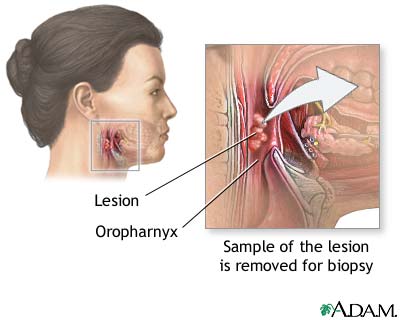An oropharynx lesion biopsy is surgery in which tissue from an abnormal growth or mouth sore is removed and checked for disease.

How the Test is Performed
Painkilling or numbing medicine is first applied to the area. For large sores or sores of the throat, general anesthesia may be needed. This means you will be asleep during the procedure.
All or part of the problem area (lesion) is removed. It is sent to the laboratory to check for diseases. If a growth in the mouth or throat needs to be removed, the biopsy will be done first. This is followed by the actual removal of the growth.
How the Test will Feel
You may feel pressure or tugging while the tissue is being removed. After the numbness wears off, the area may be sore for a few days.
Why the Test is Performed
This test is done to determine the cause of a sore (lesion) in the throat.
Normal Results
This test is only done when there is an abnormal tissue area.
What Abnormal Results Mean
Abnormal results may mean:
- Cancer (such as squamous cell carcinoma)
- Benign lesions (such as papilloma)
- Fungal infections (such as candida)
- Histoplasmosis
- Oral lichen planus
- Precancerous sore (leukoplakia)
- Viral infections (such as Herpes simplex)
Risks
Risks of the procedure may include:
- Infection of the site
- Bleeding at the site
If there is bleeding, the blood vessels may be sealed (cauterized) with an electric current or laser.
Considerations
Avoid hot or spicy food after the biopsy.
Alternative Names
Throat lesion biopsy; Biopsy - mouth or throat; Mouth lesion biopsy; Oral cancer - biopsy
References
Sciubba JJ. Oral mucosal lesions. In: Flint PW, Francis HW, Haughey BH, et al, eds. Cummings Otolaryngology: Head and Neck Surgery. 7th ed. Philadelphia, PA: Elsevier; 2021:chap 87.
Sinha P, Harréus U. Malignant neoplasms of the oropharynx. In: Flint PW, Francis HW, Haughey BH, et al, eds. Cummings Otolaryngology: Head and Neck Surgery. 7th ed. Philadelphia, PA: Elsevier; 2021:chap 96.
Review Date 10/28/2024
Updated by: Ashutosh Kacker, MD, FACS, Professor of Clinical Otolaryngology, Weill Cornell Medical College, and Attending Otolaryngologist, New York-Presbyterian Hospital, New York, NY. Review provided by VeriMed Healthcare Network. Also reviewed by David C. Dugdale, MD, Medical Director, Brenda Conaway, Editorial Director, and the A.D.A.M. Editorial team.









